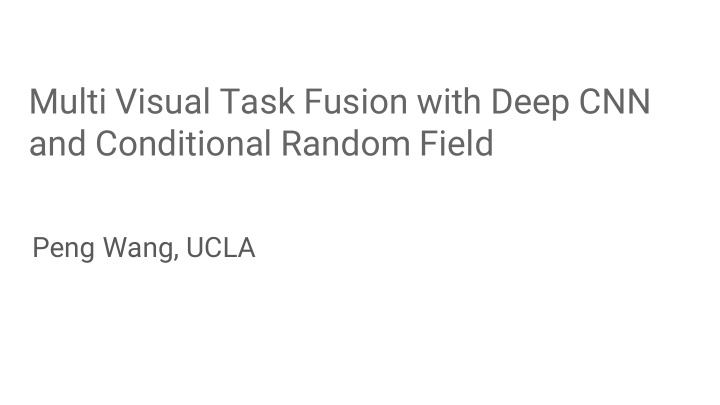



Multi Visual Task Fusion with Deep CNN and Conditional Random Field Peng Wang, UCLA
Why it is important to fuse multi-tasks in vision Human are performing multi-tasks simultaneously and register them well. Only by understanding fully and densely to the given scene, we can have confidence to do visual question and answering. Example results from Kokinnos Arxiv 1609.02132
Why it is important to fuse multi-tasks in vision Single task could be biased due to a single loss from the system is almost always limited, which can be regularized by other tasks. FCN Bertasius et.al CVPR 2016
Another example of optical flow Sevilla-Lara et.al CVPR 2016
Deep learning for pixel-wise dense prediction Long et.al CVPR 2015
Extension afterwards Edge prediction Image FCN Network Atrous FCN Multi-scale FCN Kokinnos Arxiv 1609.02132 Chen et.al ICLR 2015 Eigen&Fergus ICCV 15 Reconstruction Eigen&Fergus ICCV 15 Pose estimation Insafutdinov et.al ECCV 2016 Detection, low level processing, style transfer ...
Extension afterwards Edge prediction Image FCN Network Hypercolumn FCN Kokinnos Arxiv 1609.02132 Hariharan CVPR 2015 Encoder-Decoder Reconstruction Noh et.al ICCV 2015 Eigen&Fergus ICCV 15 Pose estimation VGG, Inception, Resnet, Inception Insafutdinov et.al ECCV 2016 Resnet etc... Detection, low level processing, style transfer ...
Conditional Random Field (CRF) Useful for structure learning and reference, which could be modeled to look at neighbor context and smooth the predictions
Fully connected CRF Difference Krahenbuhl & Koltun NIPS 2012 Access long range context in bilateral space Connect every pair
Recent applications
CRF has long been commonly used in single or multi tasks Pre-CNN period SIFT (HOG) + SVM (Structured SVM) for unary energy over pixel or super-pixel, e.g. Can be back trace to “Texton - Boost in 2007” … tones of works afterwards CNN period (Just replace the unary ? What else we have from CNN?) More efficient, unified and robust features from deep learning, which allows us to model multi- tasks more effectively.
Two applications from the intuition [1] Peng Wang , Xiaohui Shen, Zhe Lin, Scott Cohen, Brian Price, Alan Yuille, Joint Object and Part Segmentation using Deep Learned Potentials , ICCV 2015 [2] Peng Wang , Xiaohui Shen, Bryan Russel, Scott Cohen, Brian Price, Alan Yuille, SURGE: Surface Regularized Geometric Estimation from a Single Image , NIPS 2016
Joint Object and Part Segmentation
Part sharing Handle the growth of joint label space
Joint FCRF formulation
Unary Pairwise f h l
Results Less confusion and more details due to larger context and joint task performed. Better details Better semantics
Additional results Less confusion and more details due to larger context and joint task performed. Better details & semantics
3D geometry reconstruction (Depth & Normal)
Formulation of the DCRF
orthogonal compatibility
Planar Affinity Finally, we make the DCRF layer trainable for both normal and depth.
Results Better 3D planar Image Network output Regularization Ground truth
Results Image Network output Regularization Ground truth
Take home message 1. Performing multi-tasks and register them well could help visual tasks. 1. CNN and CRF could be served as an easy starting approach to model relationships. 1. Discover the complementary property could be either learned if you have large data or discovered from observations. 1. Still long way to go, and a lot of opportunities to combine and register tasks.
Recommend
More recommend